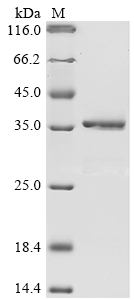The recombinant Human CSTA was expressed with the amino acid range of 2-98. The expected molecular weight for the CSTA protein is calculated to be 38.3 kDa. This CSTA protein is produced using e.coli expression system. The CSTA coding gene included the N-terminal GST tag, which simplifies the detection and purification processes of the recombinant CSTA protein in following stages of expression and purification.
Human cystatin-A (CSTA), also known as stefin A, is a member of the cystatin superfamily of cysteine proteinase inhibitors. CSTA plays a crucial role in regulating the activity of cysteine proteases by forming tight, reversible complexes with them. CSTA is primarily expressed in the epidermis, where it helps control the activity of proteases involved in skin homeostasis. Its inhibition of cathepsins protects against excessive protein degradation, contributing to the maintenance of skin integrity. Beyond its role in skin physiology, CSTA has been implicated in various pathological conditions, including cancer, where its dysregulation may influence tumor progression. Understanding CSTA's functions is vital for unraveling its diverse roles in health and disease.






